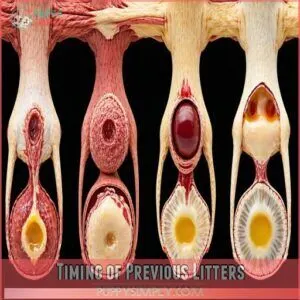This site is supported by our readers. We may earn a commission, at no cost to you, if you purchase through links.
 A dog is too old to breed when their health or age makes it risky.
A dog is too old to breed when their health or age makes it risky.
For females, fertility drops after age 5, and most breeders retire them by 8 to avoid complications. Males can breed longer, but sperm quality usually declines around 10-12 years.
It’s not just about age—watch for signs like reduced energy, fertility issues, or joint pain. Breeding older dogs can lead to difficulties for both the parent and puppies.
Always consult a vet to assess your dog’s health. Want your dog happy and healthy? Knowing when to stop breeding is a big part of responsible pet care!
Table Of Contents
- Key Takeaways
- When is a Dog Too Old to Breed?
- What is The Oldest Age a Dog Can Have Puppies?
- Signs That a Male Dog is Too Old for Breeding
- When is a Female Dog Too Old to Breed?
- Tips to Know When to Stop Breeding Your Female Dog
- Seeking Advice From Experienced Breeders
- What to Do if a Senior Dog Gets Pregnant
- Providing Proper Nutrition for a Pregnant Dog
- Getting Your Dog Accustomed to The Whelping Box
- Caring for Your Dog After Whelping
- Frequently Asked Questions (FAQs)
- What Are the Recommended Limits for Breedings in a Female Dog’s Lifetime?
- What Are the Risks of Breeding at Older Ages?
- What Signs Indicate a Decline in Male Fertility?
- How Can I Get Veterinary Guidance on Appropriate Breeding Age?
- What Should I Do if My Senior Dog Gets Pregnant?
- Is it safe for a 10 year old dog to have puppies?
- Is it okay to breed a 7 year old dog?
- At what age are dogs no longer fertile?
- What happens if a 7 year old dog gets pregnant?
- What are the recommended limits for breedings in a female dog’s lifetime?
- Conclusion
Key Takeaways
- You’ll want to retire female dogs from breeding by age 8, since their fertility drops after age 5 and they face higher risks of pregnancy complications as they age.
- You should limit your female dog to 4–6 total litters in her lifetime, with proper rest between pregnancies to protect her health and ensure successful outcomes.
- You can breed male dogs until age 10–12, but you’ll need to watch for signs of declining fertility like reduced libido, lower sperm quality, and prostate issues.
- You’ll need regular vet checkups to assess your dog’s breeding fitness, as individual health factors matter more than age alone when determining when to stop breeding.
When is a Dog Too Old to Breed?
Figuring out when a dog is too old to breed isn’t just about age—it’s about health and responsible ownership.
While female dogs don’t go through menopause, their fertility declines after age 5, with higher risks of complications like smaller litter sizes or reproductive issues. Males, on the other hand, see fertility dips around 10-12 years, often struggling with lower sperm quality, prostate disease, or fatigue during breeding.
For best breeding, understanding dog pregnancy duration is key to a healthier pregnancy experience.
Ethical breeding limits suggest females should retire after 4-6 litters and never breed after 8-9 years. Males may still sire litters later, but their overall health and stamina matter more than just hitting the dog breeding age limit.
Always consult your vet to evaluate senior dog health and minimize breeding risks, especially as dogs age.
Remember, breeding isn’t just about your dog’s fertility—it’s about their well-being and ensuring future fertility doesn’t come at a cost to their health.
What is The Oldest Age a Dog Can Have Puppies?
Knowing the oldest age a dog can have puppies depends on factors like breed, size, and overall health.
While males can remain fertile into their senior years, females face more risks and a sharp fertility decline after age 5-6.
Male Dogs
Considering male dog fertility, when’s the right time to hang up the stud hat? For most, male dog fertility starts to decline around 10-12 years.
Think of it like this: your senior stud dogs are like fine wine – excellent for a while, but eventually, they start to lose their zest. Before then, they’re usually raring to go. But after that age, breeding risks increase substantially. Prostate issues become more common, and sperm quality can dip, leading to lower conception rates.
You’ll also want to understand the female’s dog heat cycle duration, so you can better time breeding.
So, what’s the male dog breeding age limit? While there’s no hard and fast rule, aiming for breeding before age 10-12 is a smart move. This guarantees you’re maximizing your chances of healthy puppies and minimizing potential health problems for your senior dog.
Remember, responsible breeding means prioritizing the well-being of your canine companion, and knowing when to stop breeding your dog is part of that. A vet can provide further insights on male dog fertility age and help you determine the best time to retire your beloved stud.
Female Dogs
For female dogs, breeding after 5 to 6 years old carries higher risks, including birthing issues and difficulty nursing puppies. Fertility in female dogs starts to drop around this time, so it’s important to think about their health, conception rates, and litter sizes before moving.
Larger breeds typically retire by 5 years old, while smaller ones may continue until 7.
When choosing a breed, research their healthiest characteristics and genetic predispositions, such as those of the healthiest dog breeds.
Ethical breeding means prioritizing the female dog’s health and keeping her total litters to four to six in her lifetime. Overbreeding can harm both the dam and her puppies, so keep an eye on her well-being and work closely with your vet.
Proper nutrition during pregnancy and a safe, cozy whelping box are key to healthy puppy care and senior dog care.
Signs That a Male Dog is Too Old for Breeding
Knowing when your male dog is too old for breeding is essential for his health and the success of the process. While every dog is different, there are clear signs that it’s time to retire him from breeding. Here’s what to watch for:
- Reduced Libido: An older dog may show less interest in mating, which is natural due to declining testosterone levels. If your dog seems less motivated, it’s a sign his breeding days might be behind him.
- Sperm Quality: Aging impacts sperm mobility and viability. Even if mating occurs, lower-quality sperm can lead to reduced litter sizes or failed pregnancies. Semen analysis by a veterinarian can confirm this.
- Prostate Issues: Older male dogs are at higher risk of developing prostate problems, which can cause discomfort, difficulty in mating, or even infertility. Watch for signs like straining to urinate or blood in the urine.
- Breeding Difficulties: Physical challenges, such as joint pain or fatigue, might make breeding uncomfortable or unsafe for your dog. This is a common concern as he approaches the maximum age for breeding dogs, typically 10-12 years.
Regular veterinary checkups will help determine the right time to stop breeding your dog responsibly.
When is a Female Dog Too Old to Breed?
Determining when a female dog is too old to breed involves balancing her health, fertility, and quality of life. Most female dogs should stop breeding between 5 and 6 years old, depending on the breed. Smaller breeds may have a slightly longer window, while larger breeds face higher health risks as they age.
As dogs grow older, fertility declines sharply, litters become smaller, and complications like difficult pregnancies or delivery issues become more likely. Additionally, a female dog’s physical changes, such as dog nipples enlarged, should also be considered when evaluating her breeding suitability.
To make fair decisions, keep these guidelines in mind:
| Factor | Recommended Age Limit | Key Risks in Older Dogs |
|---|---|---|
| Breed size | Small: ~7 years, Large: ~5-6 | Difficult pregnancies, lower energy |
| Fertility decline | Around 5-6 years | Smaller litter sizes, risk of miscarriage |
| Health concerns | After 4-6 litters total | Increased strain on heart and organs |
Breeding female dogs ethically means spacing litters appropriately to allow recovery and retiring them within reasonable age limits. Always consult your vet to assess your dog’s individual health and risks. Remember, their well-being should trump any drive to breed. After all, you’ve already given her the chance to bring new life into the world—it’s okay to let her relax!
Tips to Know When to Stop Breeding Your Female Dog
Knowing when to stop breeding your female dog helps protect her health and well-being as she ages. Pay attention to factors like litter history, timing, and her overall physical condition.
Consider The Dog’s Breed
Breed size matters when deciding a female dog’s breeding age. Smaller breeds often have longer reproductive windows, while larger breeds hit dog breeding limits earlier due to shorter lifespans.
Pay attention to breed-specific health issues and genetic predispositions.
Sticking to dog breeding best practices guarantees you avoid risks tied to breed standards and meet the ideal breeding age for safe pregnancies.
Breed to Improve
Every breeding opportunity is a chance to fine-tune your dog’s lineage. Look for desirable traits in each parent to enhance the breed.
Remember dog breeding age limits and the impact of dog fertility decline. Older dogs face increased risks; pregnancy and birthing become more challenging.
Breed standards provide guidance, but responsible dog breeding goes further. Consider outcrossing benefits to boost genetic health and avoid linebreeding risks.
Aim for a strong puppy temperament, a hallmark of responsible dog breeding. Always seek veterinary advice to navigate the complex world of dog breeding health risks and the ideal breeding age for your canine companion.
Examine The Number of Litters Produced
Pay attention to the total litter count over your dog’s life. Smaller or declining litter size trends can hint that it’s time to step back. Too many litters may stress your dog and impact her health.
- Track the ideal litter number (4-6 per lifetime).
- Watch for dog fertility decline.
- Note changes in litter frequency.
- Consider her overall breeding lifespan.
Timing of Previous Litters
Keep track of the timing between your female dog’s litters to assess if breeding should stop. If the intervals are getting longer or the litter size trends are shrinking, it could signal fertility decline.
Frequent breedings or producing over four to six litters in her dog breeding lifespan increases health implications.
For senior dogs, breeding frequency should slow down or end entirely. Older pregnancies carry risks, so consult your vet to evaluate her health and fertility.
The breeding age limit for dogs varies, but monitoring intervals and her overall condition guarantees a safe dog breeding retirement age. Breeding should stop when fertility declines.
Health Considerations
When deciding to stop breeding, always factor in your female dog’s health alongside her age.
Older dogs face higher risks during pregnancy, delivery, and nursing. Females over 5-6 years old often encounter issues like pyometra or uterine prolapse, while declining fertility can lead to smaller, weaker litters.
As they age, dogs may also experience cognitive decline symptoms, which can impact their quality of life.
These breeding risks also impact puppy health and strain the mother’s recovery.
For males, senior dog health declines after 10-12 years, with reduced sperm quality and risks of disease transmission.
To prioritize genetic risks and canine reproductive aging, consult a vet regularly.
Monitoring dog reproductive health safeguards safety for both pets and puppies.
Seeking Advice From Experienced Breeders
Connecting with experienced breeders can be a game-changer. They’ve seen it all—what works, what doesn’t—and their advice can help you navigate key decisions like breed selection, ethical breeding, and managing risks in older dog breeding.
Most breeders agree that female dogs should retire from breeding by age 5-7, depending on their size, while males typically stop around 10-12 years. These guidelines aren’t arbitrary; they’re based on health concerns like reduced fertility, genetic health risks, and increased complications with age.
Ethical breeding also means factoring in your dog’s recovery time. Allow at least one heat cycle between litters for your female’s health to recover fully. Experienced breeders will stress the importance of tracking lifetime litters—4-6 is the maximum for most dogs. Pushing beyond that increases risks for both mom and puppies.
Don’t forget to ask about genetic testing and stud fees. Breeders can guide you on how to choose healthy mates to avoid passing on hereditary issues. Whether you’re uncertain about the dog’s maximum age for breeding or simply need guidance, tapping into their knowledge guarantees you’re making informed, responsible choices.
What to Do if a Senior Dog Gets Pregnant
If your senior dog is pregnant, it’s time to roll up your sleeves and give her the special attention she needs. Breeding older dogs comes with a unique set of challenges, so staying prepared is key. Here’s how to support her for a healthy, safe delivery:
- Set up a whelping box: Create a quiet, comfortable space where your dog can deliver her puppies. Use soft bedding and keep extra blankets handy to swap out as needed. Familiarize her with the area well before delivery.
- Address nutrition needs: Senior dog pregnancy risks include nutritional deficiencies, so feed her a high-quality diet specifically for pregnant or nursing dogs. Small, frequent meals can help with digestion.
- Follow vet advice: Schedule regular checkups to monitor her health and discuss potential age-related concerns like lower fertility or birthing difficulties. Your vet might suggest supplements or ultrasounds to track the puppies’ progress.
With these steps, you’ll help both mom and pups thrive.
Providing Proper Nutrition for a Pregnant Dog
So, your senior dog’s pregnant? Wow! That’s a lot to handle. Now, let’s talk about nutrition. Getting your dog’s nutritional needs met during pregnancy is key. Think of it like fueling a race car—you need the right fuel for peak performance.
Focus on high-quality puppy food. These formulas are packed with the vitamins, minerals, and protein she needs to support those growing puppies and maintain her own health. Don’t just guess at portion sizes; monitor her pregnancy weight gain closely with your vet’s guidance. They can help you determine the right dog calorie intake. You can also explore specialized pregnant dog food options to find the best fit for your dog.
Food choices matter. Avoid table scraps and human food. Stick to her vet-approved diet. Consider adding a prenatal supplement specifically for dogs. These can boost her intake of essential nutrients. Your vet can advise on the best supplement use.
Dietary concerns during dog pregnancy are common. Vomiting, decreased appetite, and changes in bowel movements are all possibilities. If you notice anything unusual, reach out to your vet immediately. Remember, this is a marathon, not a sprint. Proper dog nutrition is an investment in a healthy mom and happy, healthy pups. A balanced diet helps you handle dog health considerations, reducing unexpected complications and easing your worries during this special time.
Getting Your Dog Accustomed to The Whelping Box
Getting your dog comfortable with the whelping box isn’t hard, but it takes patience. Start by choosing the right spot—quiet, warm, and away from foot traffic. Place the box early in the pregnancy, so she’s plenty of time to adjust. Gradual introduction is key. Encourage her to explore the space using positive reinforcement like treats or praise. Add comfort items like her favorite blanket or toys to create a familiar, safe environment. You can even rub her bedding inside the box for scent familiarization.
Here’s how to ease the process:
- Pick a quiet, cozy location for the box placement.
- Introduce your dog slowly to the box over a few days.
- Use treats for positive reinforcement.
- Include familiar smells and comfort items.
- Praise her when she uses it willingly.
Caring for Your Dog After Whelping
After settling your dog into her whelping box, it’s time to focus on post-whelping care. Think of this stage as the postpartum chapter for your furry friend.
Start with her diet—boosting her nutrition with high-quality protein sources is a must. A well-fed mom means healthier puppies.
A senior dog whelping box for comfortable recovery can help minimize stress and fatigue.
For oral hygiene, brush her teeth regularly to prevent issues that could affect her overall health.
Watch for signs of anxiety or stress; calming toys like the Calmeroos puppy toy can soothe her and help with bonding time.
Monitoring the litter is equally important—keep an eye out for older dams’ puppy issues, like weak nursing or fatigue.
Frequently Asked Questions (FAQs)
What Are the Recommended Limits for Breedings in a Female Dog’s Lifetime?
Want to guarantee your dog’s health during breeding?
You shouldn’t exceed 4-6 litters in your female dog’s lifetime.
Wait until the third heat cycle before starting.
Maintain adequate rest periods between pregnancies.
What Are the Risks of Breeding at Older Ages?
Your dog’s breeding risks increase with age, including smaller litters, difficult pregnancies, and health complications.
You’ll notice reduced fertility after age 5 in females and 10 in males, plus higher chances of birth defects.
What Signs Indicate a Decline in Male Fertility?
Like an aging athlete past their prime, you’ll notice reduced mating interest, smaller litter sizes, and decreased sperm count in males over
Watch for signs of prostate disease and overall weakness during breeding attempts.
How Can I Get Veterinary Guidance on Appropriate Breeding Age?
Schedule a thorough health check with a veterinarian specializing in reproductive health.
They’ll assess your dog’s physical condition, medical history, and breed-specific factors to determine the safest breeding timeline for your pet.
What Should I Do if My Senior Dog Gets Pregnant?
Time moves like sand through an hourglass for senior dogs.
Contact your vet immediately for monitoring and potential risks.
They’ll guide you through proper nutrition, exercise limits, and specialized care for both mom and puppies.
Is it safe for a 10 year old dog to have puppies?
No, it’s not safe for a 10-year-old dog to have puppies.
At this age, they face higher risks of complications, reduced fertility, and health issues.
You should consult your vet about spaying to prevent accidental pregnancy.
Is it okay to breed a 7 year old dog?
You’re playing with fire breeding a 7-year-old dog.
While some smaller breeds might handle it, there’s a higher risk of complications.
It’s best to retire female dogs from breeding after 5-6 years.
At what age are dogs no longer fertile?
Female dogs typically become less fertile after age 5, with fertility ending around 8-9 years.
Male dogs can stay fertile longer, but their fertility declines after 10 years, with most becoming infertile by
What happens if a 7 year old dog gets pregnant?
A 7-year-old dog’s pregnancy comes with higher risks of complications.
Including difficult labor and potential health issues for both mom and puppies.
Your vet should closely monitor the pregnancy for everyone’s safety.
What are the recommended limits for breedings in a female dog’s lifetime?
Responsible breeders limit their dogs to 4-6 litters throughout their lifetime.
It’s important to wait until the third heat cycle and stop breeding by age 5-7, depending on your dog’s breed size.
Conclusion
Deciding when your dog’s too old to breed isn’t just about picking a number – it’s about being a responsible pet parent.
Watch for those telltale signs: slowing down, health issues, or reduced fertility.
Female dogs typically retire from breeding around 8, while males can go until 10-12, but every dog’s different. Trust your vet’s advice and put your furry friend’s health first.
After all, knowing when a dog’s too old to breed helps guarantee happy, healthy pups for everyone. Knowing when a dog’s too old to breed is important for responsible pet parenting.



















